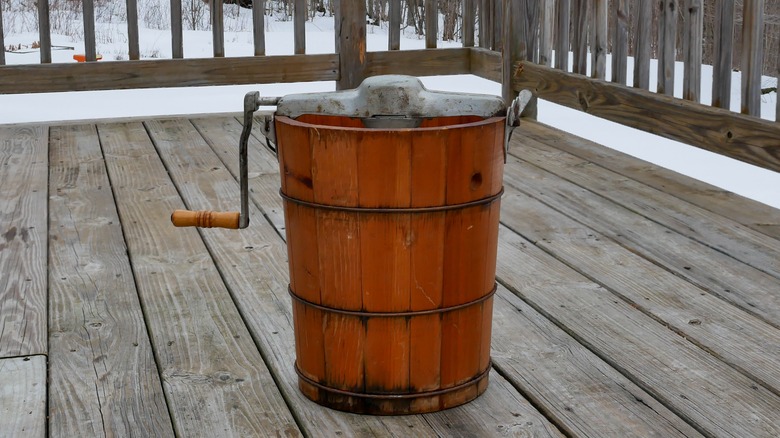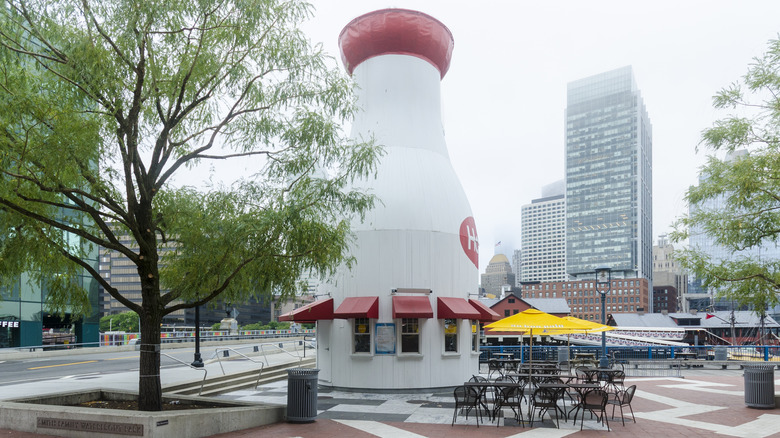What Makes New England-Style Ice Cream Different From The Rest?
It's winter in New England: cold, long, and snowy. The streets are slushy. The wind is biting. Most people have switched to hot Dunkin' coffee and some people have stopped wearing shorts. The ice cream shops, though, they never close — no matter the season, New England is all about ice cream. Back in 1987, the International Ice Cream Association found that New Englanders ate 151% more ice cream than the national average. And for good reason: New England ice cream is different — and if you ask any New Englander, it's better.
New England ice cream is richer, creamier, and chewier than other ice creams. This is primarily because there's less overrun, the term for how much air is whipped into the ice cream as it's being churned. Think of it like the difference between cream and whipped cream, or chocolate ganache for truffles versus whipped ganache frosting.
The overrun of ice cream is calculated by determining the percent increase of volume when making ice cream; for example, 1 cup of base that becomes 1½ cups of ice cream has 50% overrun, and 1 cup of base that yields 1¾ cups of ice cream has 75% overrun. A brand like Edy's has close to 100% overrun. New England ice creams, on the other hand, typically have only 50% to 60% overrun. This leads to ice cream so dense it's easiest to just bite it off the cone, in a good way.
Getting the right New England ice cream texture
As New Englanders know, one of the secrets to ice cream that doesn't melt is to eat it in a snowstorm. The other secret is that it has to be very, very thick. While many premium ice creams are thickened with egg yolks, New England-style ice cream isn't dependent on eggs for its texture. Sometimes it'll include egg yolks, sometimes it'll be thickened instead with starch or gelatin. But the texture of New England-style ice cream, which is so dense it barely melts, is thanks to how slowly it's churned.
That dense, chewy texture comes from low, low, low overrun. Judy Herrell, the current owner of the legendary Massachusetts ice cream shop Herrell's, explains in an interview with Serious Eats that ice cream needs some overrun or it comes out too heavy; you can't just pop an ice cream base in the freezer and expect it to come out smooth and creamy once it's frozen solid. But to get the right consistency, you can't let the machine run too fast. You need a slow-churn ice cream maker.
What you really need, Herrell says, is a hand crank, bucket-style ice cream maker — the kind that uses ice and rock salt around the canister. This allows you to make high fat, low ice, high cream, low air ice creams in classic New England flavors like rum raisin, tutti fruitti, and purple cow ice cream (or any flavor that you think is wicked awesome).
A brief history of New England ice cream
Ice cream may have been invented in China sometime between the seventh and tenth centuries, but New England changed it forever, and the historical heart of New England ice cream is the Boston area. Before there was Vermont's favorite duo, Ben and Jerry, there was Harvey Perley Hood, Howard Johnson, and Steve Herrell.
Hood Creamery, a New England staple brand founded in 1846, started producing ice cream around the turn of the 20th century with a focus on quality milk and cream in the recipe. Herbert Wolff, a co-author of the 1985 classic "The Very Best Ice Cream and Where to Find It" says that the popularization of ice cream in the U.S. was a "phenomenon of the Depression." Dairy farmers in New England realized that they could get ten times the revenue from ice cream than they could by selling milk. In 1925, Howard Johnson bought a drug store in Quincy, MA, and started experimenting with ice cream flavors and butterfat percentages, creating creamier, more creative ice cream; Howard Johnson's was known for its 28 flavors.
Steve Herrell is to thank for modern ice cream: He converted a small batch freezer into a slow-churn ice cream maker in Somerville, MA in 1973, and was the first person to crush up baked goods and candies and add them to ice cream. He created Cookies 'n' Cream and Heath Bar Crunch. Shortly after, in 1978, Ben and Jerry opened an ice cream shop in Burlington, Vermont.


